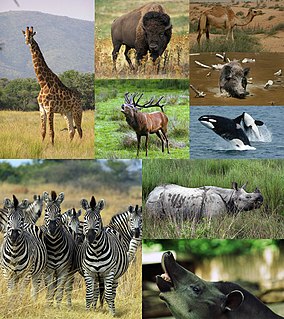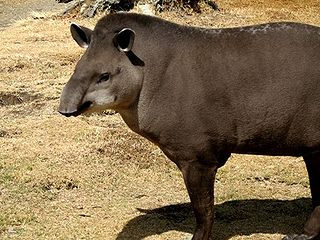
Odd-toed ungulates, mammals which constitute the taxonomic order Perissodactyla, are animals—ungulates—who have reduced the weight-bearing toes to three or one of the five original toes. The non-weight-bearing toes are either present, absent, vestigial, or positioned posteriorly. By contrast, the even-toed ungulates bear most of their weight equally on four or two of the five toes: their third and fourth toes. Another difference between the two is that odd-toed ungulates digest plant cellulose in their intestines rather than in one or more stomach chambers as even-toed ungulates, with the exception of Suina, do.

Ungulates are members of the diverse clade Ungulata which primarily consists of large mammals with hooves. These include odd-toed ungulates such as horses, rhinoceroses, and tapirs; and even-toed ungulates such as cattle, pigs, giraffes, camels, sheep, deer, and hippopotamuses. Cetaceans such as whales, dolphins, and porpoises are also classified as even-toed ungulates, although they do not have hooves. Most terrestrial ungulates use the hoofed tips of their toes to support their body weight while standing or moving.

Tapirs are large, herbivorous mammals belonging to the family Tapiridae. They are similar in shape to a pig, with a short, prehensile nose trunk. Tapirs inhabit jungle and forest regions of South and Central America, with one species inhabiting Southeast Asia. They are one of three extant branches of Perissodactyla, alongside equines and rhinoceros. Only a single genus, Tapirus is currently extant. Tapirs migrated into South America during the Pleistocene epoch from North America after the formation of the Isthmus of Panama as part of the Great American Interchange. Tapirs were once widespread in North America until the arrival of humans at the end of the Late Pleistocene, around 12,000 years ago.

The South American tapir, also commonly called the Brazilian tapir, the Amazonian tapir, the maned tapir, the lowland tapir, in Portuguese anta, and in mixed Quechua and Spanish sachavaca, is one of the four widely recognized species in the tapir family, along with the mountain tapir, the Malayan tapir, and the Baird's tapir. It is the largest surviving native terrestrial mammal in the Amazon.

Tapirus is a genus of tapir which contains the three living American tapir species. The Malayan tapir is usually included in Tapirus as well, although some authorities have moved it into its own genus, Acrocodia.

The Malayan tapir, also called Asian tapir, Asiatic tapir and Indian tapir, is the only tapir species native to Southeast Asia from the Malay Peninsula to Sumatra. It has been listed as Endangered on the IUCN Red List since 2008, as the population is estimated to comprise less than 2,500 mature individuals.

The mountain tapir, also known as the Andean tapir or woolly tapir is the smallest of the four widely recognized species of tapir. It is the only one to live outside of tropical rainforests in the wild. It is most easily distinguished from other tapirs by its thick woolly coat and white lips.

The Baird's tapir, also known as the Central American tapir, is a species of tapir native to Mexico, Central America, and northwestern South America. It is the largest of the three species of tapir native to the Americas, as well as the largest native land mammal in both Central and South America.

Moeritherium is an extinct genus of primitive proboscideans. These prehistoric mammals are related to the elephant and, more distantly, sea cows and hyraxes. They lived during the Eocene epoch.
Tapir Gao is an Indian politician. He is the president of Arunachal Pradesh unit of Bharatiya Janata Party (BJP). He was a member of the 14th Lok Sabha (2004-2009), representing the Arunachal East constituency for BJP. He lost from that seat in 2009 and 2014, but was elected to Lok Sabha for the second time in 2019. Gao was General Secretary of BJP in 2011 and is currently national executive member of the BJP.
April is the fourth month of the year.

Melbourne Bone Bed is a paleontological site located at Crane Creek in Melbourne, in the U.S. state of Florida. This site contains fossils from the Late Pleistocene period 20,000 to 10,000 years before present. The fossils include extinct animals such as varieties of camels, dire wolves, Florida cave bears, giant armadillos, giant beavers, giant bison, giant ground sloths, mammoths, mastodons, saber-toothed cats and tapirs.

The Soviet designation Project 1171 (Tapir-class) landing ship is a class of Soviet / Russian general purpose, beachable amphibious warfare ships.

Tapiroidea is a superfamily of perissodactyls which includes the modern tapir. Members of the superfamily are small to large browsing mammals, roughly pig-like in shape, with short, prehensile snouts. Their closest relatives are the other odd-toed ungulates, including horses and rhinoceroses. Taxonomically, they are placed in suborder Ceratomorpha along with the rhino superfamily, Rhinocerotoidea. The first members of Tapiroidea appeared during the Early Eocene, 55 million years ago.
Warekena (Guarequena), or more precisely Warekena of Xié, is an Arawakan language of Brazil and of Maroa Municipality in Venezuela, spoken near the Guainia River. It is one of several languages which go by the generic name Baré and Baniwa/Baniva – in this case, distinguished as Baniva de Maroa or Baniva de Guainía.

April was a tapir living at the Belize Zoo in Belize from 1983 until her death in 2013. She was a Baird's tapir, the national animal of Belize.

Tapirus veroensis, commonly called the vero tapir, is an extinct tapir species that lived in the areas of modern-day Florida, Georgia, Kansas, Missouri, and Tennessee. Tapirus veronensis is thought to have gone extinct around 11,000 years ago.
Óliver Ramos, better known as Tapir 590 or Quinientos Noventa, is a Peruvian Internet celebrity and phenomenon. He became known for his videos where he showed off his luxuries and his famous phrase "Claro pe', mascota".












